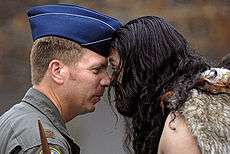Hongi

The traditional Māori greeting, the Hongi is done by pressing one's nose and forehead, at the same time, to another encounter. It is used at traditional meetings among Māori people and on major ceremonies and serves a similar purpose to a formal handshake. In the hongi, the ha (or breath of life), is exchanged.[1] The breath of life can also be interpreted as the sharing of both people’s souls.
Through the exchange of this greeting, one is no longer considered Manuhiri, a visitor, but rather Tangata whenua, one of the people of the land. For the remainder of the stay, one is obliged to share in all the duties and responsibilities of the home people. In earlier times, that may have meant bearing arms in times of war or tending crops, such as kumara.
When Māori greet one another by pressing noses, the tradition of sharing the breath of life is considered to have come directly from the gods. In Māori mythology, woman was created by the Gods moulding her shape out of the earth. The god Tane embraced the figure and breathed into her nostrils. She then sneezed and came to life, creating the first woman in Māori legends, Hineahuone.[2]
Examples
- Performed by Hillary Clinton by a 4 November 2010 visit to Wellington[3]
- Performed by Ambassador of Turkey Ali Yakıtal[4]
- Performed by Prince William and Sir Paul Reeves[5]
See also
- Eskimo kissing, a similar gesture
References
- ↑ Derby, Mark (September 2013). "Ngā mahi tika". Te Ara - the Encyclopedia of New Zealand. Retrieved 8 September 2017.
- ↑ Derby, Mark (September 2013). "Ngā mahi tika - Welcome and hospitality: Origin of the hongi". Te Ara - the Encyclopedia of New Zealand. Retrieved 8 September 2017.
- ↑ "Hillary Clinton's First Powhiri Hongi". scoop.co.nz. 2010. Retrieved 26 September 2011.
Scoop Images: Hillary Clinton's First Pōwhiri Hongi
- ↑ "Hongi | The Governor-General of New Zealand Te Kawana Tianara o Aotearoa". gg.govt.nz. 2011. Archived from the original on 14 November 2014. Retrieved 26 September 2011.
The Ambassador of Turkey, HE Ali Yakital, hongis a member of the Defence Force Cultural Party
- ↑ "Prince William on America's Cup yacht". newspix.photoshelter.com. 2011. Retrieved 26 September 2011.